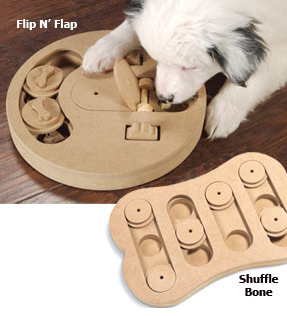Smart Toys, Or Not-So-Smart?
They’re called “puzzle” dog toys, or “interactive” dog toys, or “smart” dog toys. The idea is you put treats in little hidden areas that the dog can only access by pawing, nosing, or nudging a flap or handle in just the right way. The idea is to keep them entertained, busy, and mentally stimulated while at home, even when you’re gone.
Lots of “bad” doggie behavior is the result of lack of mental stimulation, so I like the idea behind these things. They are undeniably both mentally and physically challenging, tiring and eventually fulfilling. But something has always worried me about them, and I finally decided to get clear about exactly what it is.
A WORRY

Now maybe there are the super-smart Blue Heelers or Border Collies who have learned exactly which flaps to push or levers to slide on these toys, that do find these toys predictable and have gained not only a new skill but lots of mental stimulation plus the satisfaction of progress and success. But I’ve never seen it.
ALTERNATIVES
So what positive alternatives can I recommend, that avoid what I see as the problem with these “smart” toys?
 |
| I prefer soft filling. |
If you put treats or anything bigger than kibble in a standard Kong (like in this picture), the dog experiences a little frustration getting them out. Instead, I like to fill or coat the inside of the Kong with peanut-butter or light cream cheese, and pop it in the freezer. The treat/toy lasts a long time, and there is reward with every lick. It is physically and mentally engaging, tiring, and fulfilling, but because of the constant reward not at all frustrating.
I’m also a big fan of natural rawhides, compressed rawhide, and other chew-treats like Bully Sticks, Texas Toothpicks, and the new rage natural deer antlers (they’re softer than bone but tougher than rawhide). As I’ve explained in detail before [see my post “The Great Rawhide Debate“], you have to use care when giving your dog anything that can cause esophageal or intestinal blockage. But if you supervise, experiment, and get to know your dog’s chewing tendencies and needs, rawhides and the like provide extended physical and mental stimulation while alleviating out your dog’s natural urge to chew things up (thus saving your fancy leather shoes).
 |
| Deer Antlers |
If you’re around, playing a game with your dog is something you can do indoors that is both mentally and physically stimulating. “Go Find It” (as I call it) is a classic that I and my dogs love. You have them sit and stay while you go into another room and hide a treat or favorite toy (for us it’s a squeaky rubber “Cuz” toy that they seem to think is made of pure gold). Start by putting it in plain view, and later on you can stash it on a shelf, behind books, or under the couch cushions. Then you say “Go find it!” and they race off to sniff it out or spot it (sighthounds and scent-hounds can each use their own best skills). I don’t see their searching/sniffing/tracking as frustration because they know you’ve purposely hidden it – the game is interactive with you, not with a piece of plastic.
In the great scheme of things, there are lots of worse things in the world than people giving their dogs any kind of toy or treat, much less one that’s designed to be mentally stimulating. So I certainly don’t have a major beef here. But I’ve never seen this point discussed or even mentioned, that there could be non-ideal side-effects of these toys.
If you disagree or think I’m missing the point, let me know – tell me why I’m wrong! In the meantime I’m off to shake the fridge till something falls out.
One Comment
Comments are closed.


I can agree with you that leaving the dog alone to figure out this kind of toys on his own can be a frustrating experience. I got three toys of this kind for my young malinois and she simply loves to play with them. I’ve never left her alone with it. It is OUR game. It is game of TEACHING the dog how to open every type of box with the treat inside. So I show her how to slide or move that lid or where to pull to get that draw open etc. We worked ať one or two types of boxes ať the time. Some she figured out ať once, some took some time. The point of the game was to teach her a new skill. Now she is quite capable of getting her treats on her own but we still play the game together, me stuffing the toys with treats and she getting to them. I cheer her on and praise her when she finish. The game lasts a half of an hour at most because I don’t want her to get owerexcited or frustrated. We play it two or three times per week, sometimes with only one board, other times with all three. I change the way of presenting the toys, sometimes I fill all of them and put them in front of her, sometimes she got them one ať the time but never in the same order.
This is how we play with these toys and my girl loves it. I plan to use the toys for some more challenging nose work with her like using the specific scent we’re been working with. The scent would be in one of the many nooks and boxes on the board and she is supposed to find and show it to mě. At the final stage she must ignore the food and focus only ať the scent. But for now I’m quite happy to play with her as described before and boosting her confidence with praise and treats.